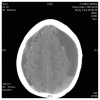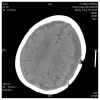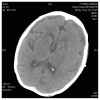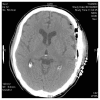Internal haemorrhagic pachymeningiosis: specific disease or complication of chronic subdural hematoma? Report of five cases surgically treated and literature review
- PMID: 25174295
- PMCID: PMC4321527
Internal haemorrhagic pachymeningiosis: specific disease or complication of chronic subdural hematoma? Report of five cases surgically treated and literature review
Abstract
Background: Internal haemorrhagic pachymeningiosis (IHP) is a rare disease characterized by a fibrous thickening and inflammatory infiltration in dural space mimicking chronic subdural hematoma. The pathogenesis of IHP is not entirely clear yet and treatment is still controversial.
Objective: We want to emphasize the importance of differentiating pachymeningiosis from chronic subdural hematoma as distinct pathological entities.
Patients and methods: The records of five selected cases of IHP histologically confirmed were reviewed, focusing onset, neuroimaging, surgery and outcomes.
Conclusions: IHP is most likely underestimated. Only through multidisciplinary approach it is possible to plane the proper therapeutic strategy. The diagnosis of IHP is confirmed by definitive histology but in some cases is possible with intraoperative frozen section.
Figures








References
-
- Gautschi OP, Gallay MN, Kress TT, et al. Chronic subdural hematoma - assessment and management. Praxis (Bern 1994) 2010;99(21):1269–77. - PubMed
-
- Sakakibara F, Tsuzuki N, Uozumi Y, et al. Chronic subdural hematoma: recurrence and prevention. Brain Nerve. 2011;63( 1):69–74. - PubMed
-
- Carangelo B, Peri G, Signori G, et al. Chronic hemispheric subdural hematoma in a patient with antibodies antiphospholipid syndrome: case report. J Neurosurg Sci. 2009;53(3):141–3. - PubMed
-
- Virchow R. Das hamatom der dura mater. Verh Phys Med Ges Wurzburg. 1857;7:134–42.
-
- Carangelo B, Siciliano M, Del Basso De Caro ML, et al. Internal hemorrahagic pachymeningiosis (PEI). Reflections on two cases. Gazz Med Ital - Arch Sci Med. 2000;159:1–4.
Publication types
MeSH terms
LinkOut - more resources
Full Text Sources
